#primozygodactylus
Explore tagged Tumblr posts
Note
Trick or treat!
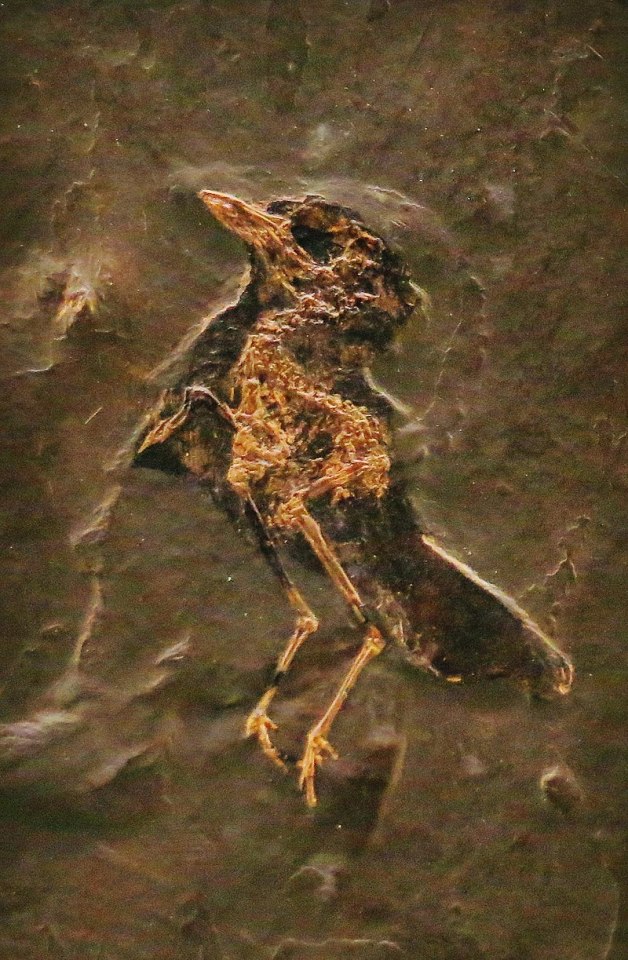
Primozygodactylus!
65 notes
·
View notes
Text
Fossil Novembirb: Day 9 - Getting a grip
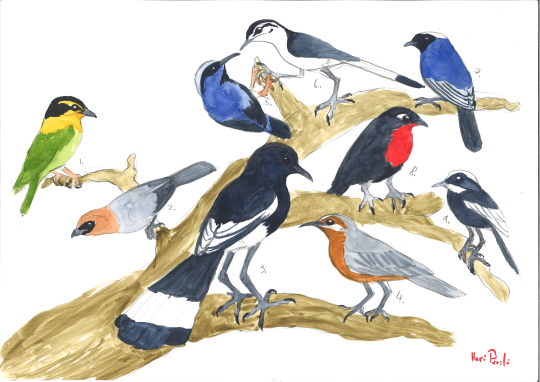
Passeriform birds are by far the most species rich bird group today, representing half of all birds (That's about 6,000 species), which is utterly wild. But before true passerines, birds in the stem-passerine lineage were already diversifying into all sorts of niches. They are equally close relatives to parrots and passeriforms, as can be seen from their passeriform-like bodies and beaks as well as their parrot-like zygodactyl feet. They were likely a big part of the Paleogene morning chorus.
Eofrillingirostrum: This Psittacopedid bird had a strong finch-like beak that was used in eating hard seeds. It lived during the early Eocene of Europe and North America.
Parapsittacopes: Another member of psittacopedes, this bird had a short beak used to eat fruit and berries. It lived 50 million years ago, and its fossils were found in the London Clay formation.
Eozygodactylus: This large member of the Zygodactylid family had long legs with parrot-like feet. These birds lived in North America during the early Eocene, 50 million years ago.
Sororavis: This rather strange member of the stem-passeriforms was found from the Fur Formation of Denmark, around 50 million years ago.
Pumiliornis: A long beaked stem-passeriform from Messel lake, around 40 million years ago. It was the first known bird to have eaten nectar, using its long beak to get it from flowers.
Primozygodactylus: Another member of the Zygodactylid group which lived all over Europe during the Eocene, but is best known from Messel Lake.
Psittacopes: A Psittacopedid bird with short legs and parrot-like feet. This frugivorous bird lived in many parts of Europe during the Eocene.
Psittacomimus: A Psittacopedid bird from the London Clay formation, this bird had zygodactyl feet like parrots as well as a short, rounded beak for eating seeds and fruit.
Zygodactylus: One of the smaller members of the long legged zygodactylids. It was a very successful bird, as its remains have been found from Europe and North America, and it persisted from the early Eocene to the Oligocene.
#Fossil Novembirb#Novembirb#Dinovember#birblr#palaeoblr#Birds#Dinosaurs#Cenozoic Birds#Eofrillingirostrum#Parapsittacopes#Eozygodactylus#Sororavis#Pumiliornis#Primozygodactylus#Psittacopes#Psittacomimus#Zygodactylus
53 notes
·
View notes
Text

Fossil Novembirb: Day 9
A male Primozygodactylus attempts to court a female
25 notes
·
View notes
Text
Fossil Novembirb, the first nine days
Hello World. I never thought I'd be on this site, but here I am. This blog was created for the purpose of participating in a-dinosaur-a-day's Fossil Novembirb. Fossil Novembirb is a yearly art event founded by Meig Dickson, a vertebrate palaeontologist who, as far as I can tell, studies dinosaurs, especially theropods. Don't fight me or em over birds being theropod dinosaurs. Neither ey nor I want to have this conversation, so enjoy the art!
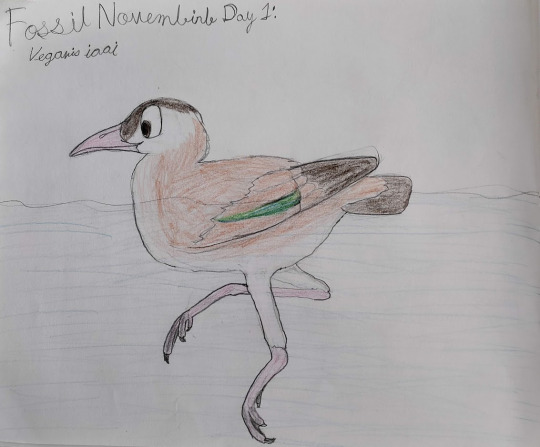
I started off my Fossil Novembirb with Vegavis iaai. What makes this fluffy anseriform special is that we found a fossilised syrinx (avian voice-maker) belonging to one of these, so we can reconstruct their sounds. This Vegavis was coloured based on a bunch of anseriforms that are alive today, like ruddy shelducks and cotton pygmy geese.

For Day 2, I did a bit of spec evo and pulled out a scientific name I told myself I'd assign to a newly-discovered fossil genus. This sketch has a Serina-like text description for Phantasmavis.
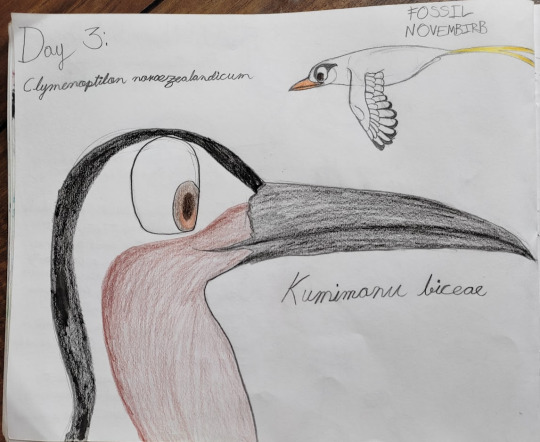
Tropicbirds! I chose to draw Clymenoptilon because I was hoping "tropicbird" meant "brightly coloured bird". Even though they aren't that brightly coloured, they're still cool. And Kumimanu (approximately to scale in this drawing) didn't really have the obligation to be black-and-white like most extant penguins (because Inkayacu), so I went... mild-wild with the colours.
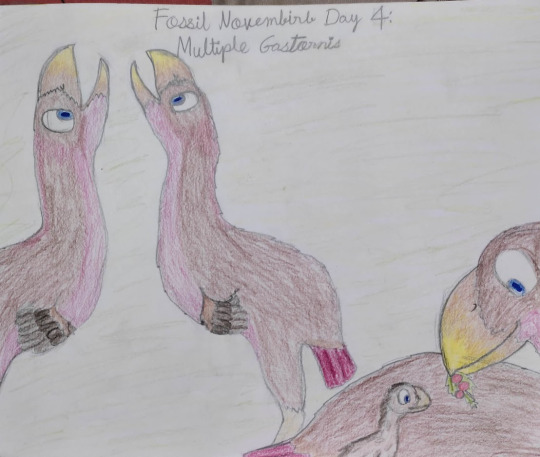
No... one's... tall like Gastornis, no one calls like Gastornis! In the bottom right, no one feeds small like Gastornis!
I've seen the "Andy's Prehistoric Adventures" episode featuring these megafowl, realised it was Walking With Dinosaurs with a human inserted, and drawn a mildly speculative colouration for these Gastornis. To the left, two adults have their necks out towards each other and are calling into the sky. Whether this is courtship or a challenge, nobody knows. But a calmer scene happens in the bottom right, where a mother shows her chick red berries on a branch to show them that it is food.
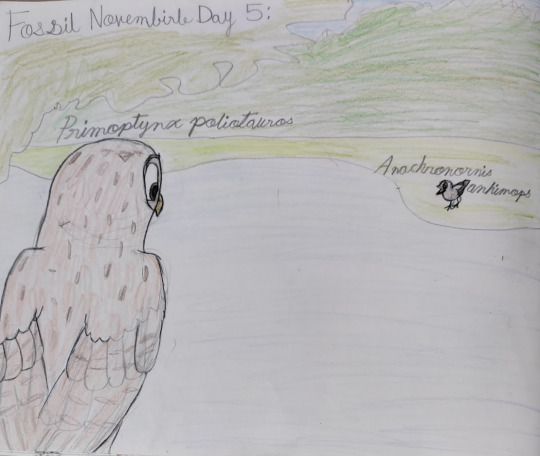
"Don't make me fly up there, you punk!" is one way to interpret the screamerduck Anachronornis' call in the direction of the Primoptynx owl. This scene unfolds in the Palaeocene-Eocene Thermal Maximum ecosystem of the Willwood Formation before it was rock.
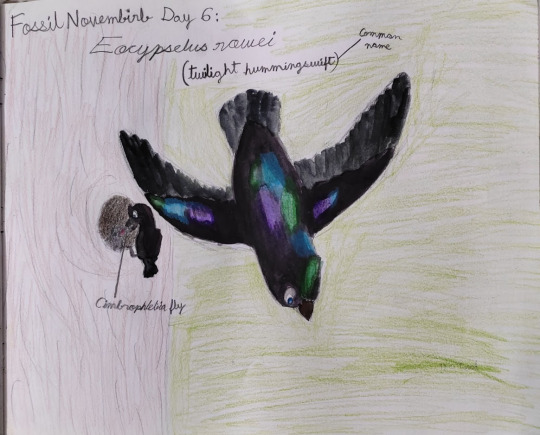
It's a twilight hummingswift! We know the colour of this iridescent little birb from the Danish Fur Formation. I watched a tutorial on painting iridescence, but I'm not really satisfied with the parent feeding their chick to the left of the flying Eocypselus rowei. It's hard to see, but there's a baby hummingswift being fed a Cimbrophlebia scorpionfly.
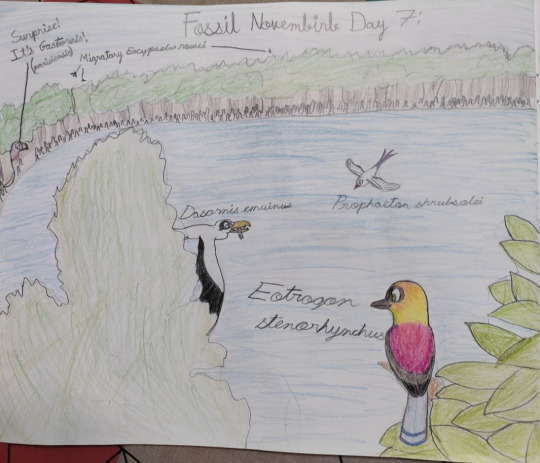
London Clay has a lot of plant fossils. Not all of them are listed on Wikipedia, but there's a photo of a pencil-root mangrove seed listed. Featuring a speculatively-coloured Eotrogon, a Dasornis carrying away a mackerel, and a Prophaeton just gliding, and repeat telecasts Gastornis parisiensis and Eocypelus rowei, Eocene London was a birder's dream (believe me, I'm a kinda-birder).
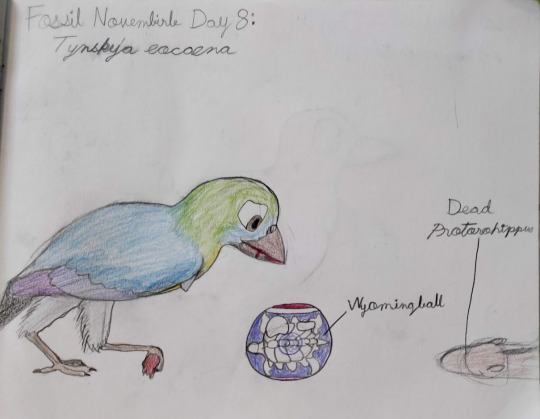
This Tynskya art was somewhat late, rather dissatisfactory, and mildly rushed. I had an exam the next day. Don't judge me.
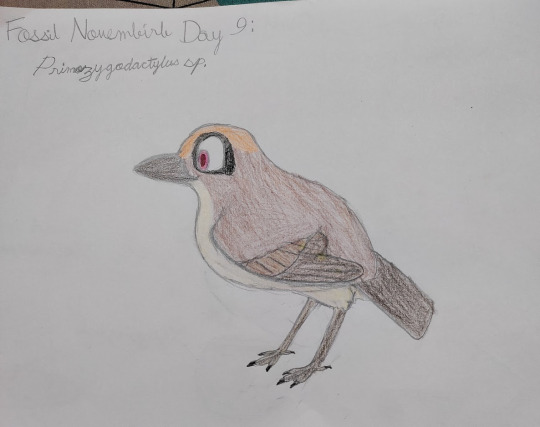
And here's a better Primozygodactylus! I couldn't tell the specific species because it wasn't listed for the Wikipedia image. But here we are: a bird that gives off ashy prinia/sparrow/orange-headed thrush vibes.
This concludes the first nine days! I don't know if I'll be doing the tenth because nobody's giving me straight answers about the palaeobotany of the Green River formation.
Enjoy!
#fossil novembirb#dinosaur#birds#paleoart#this site is as chaotic as it seemed when I first anonymously browsed eir blog#paleogene#palaeogene#eocene#cenozoic#maastrichtian
23 notes
·
View notes
Photo
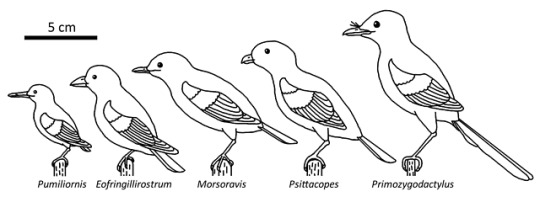
Passerines represent 60% of modern bird diversity today, but we haven't found any fossils of them from the Eocene. Instead, their close relatives took up many of the niches that they would fill in the future. Unfortunately, by the middle Miocene, most of these stem-passerines had become extinct.
Full view
#Palaeoblr#Birblr#Birds#Dinosaurs#Passerines#Pumiliornis#Eofringillirostrum#Morsoravis#Psittacopes#Primozygodactylus
16 notes
·
View notes
Text
Fossil Novembirb 9: Getting a Grip
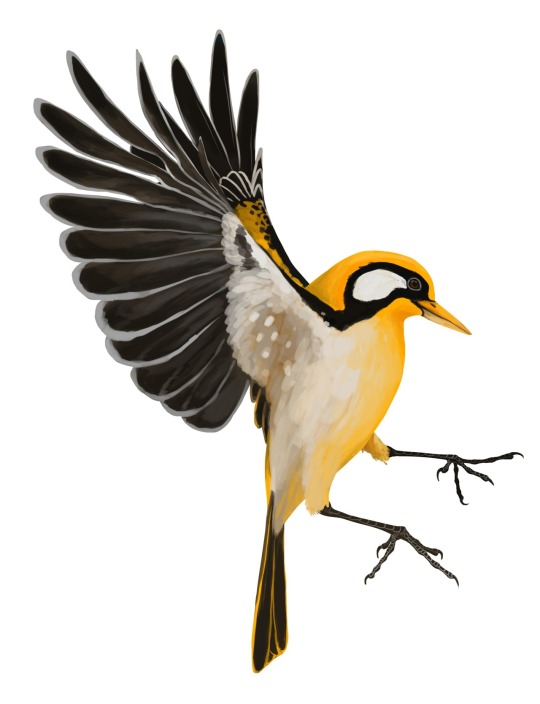
Zygodactylus by @thewoodparable
Today, half of all birds - so half of all living dinosaurs - are in a clade called Passeriformes, aka "Perching Birds". Of course, not all birds that perch are in this clade, but what can you do. With three toes forward and one long toe facing back, these animals can easily perch upright on branches and have tendons in their legs to help stiffen their grip while sleeping, enabling them to stay put!
But where did this giant group get started?
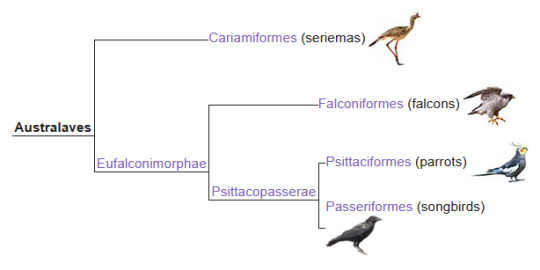
Australaves phylogenetic tree from Wikipedia
For a while, the prevalent idea was that they evolved from similar birds that perch in trees, such as pigeons and swifts. However, genetic evidence showed that the closest relatives of passerines were actually... parrots! And their closest relatives are Falcons, and just outside of that, Seriemas! What a wild twist!
Of course, paleontologists - being paleontologists - wanted to find the fossil evidence of this evolution. Luckily, as the genetic picture became clear, so did the fossil one - a handful of fossil birds that were mysteries before suddenly became clear, and more and more are being found as time goes on.
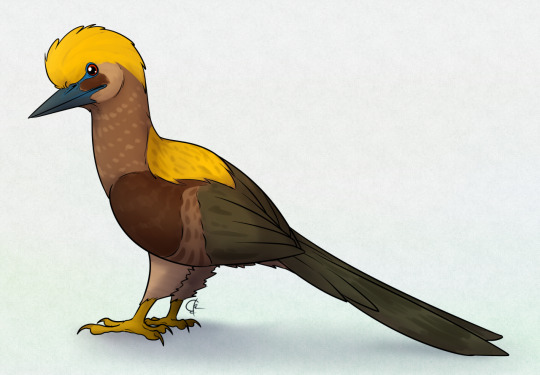
Primozygodactylus by @quetzalpali-art
In the Early Eocene, many of these early Passerine-Parrot relatives existed, and showcase a fascinating stepwise evolution of Passerine characteristics - namely, the feet. While the smaller head and size of Passerines evolved first, and show up in early relatives such as Zygodactylus, the foot arangement? Not so much. Instead, these animals had the bodies of passerines, and the feet of parrots! This indicates that the skinny legs and specialized wing shape of Passerines evolved first, and the special feet second. Truly, this and the many other stem-passerines we have found with this configuration qualify as "Evolutionary Missing Links". Dinosaurs remain our best way to show how evolution has happened over time! But I digress.
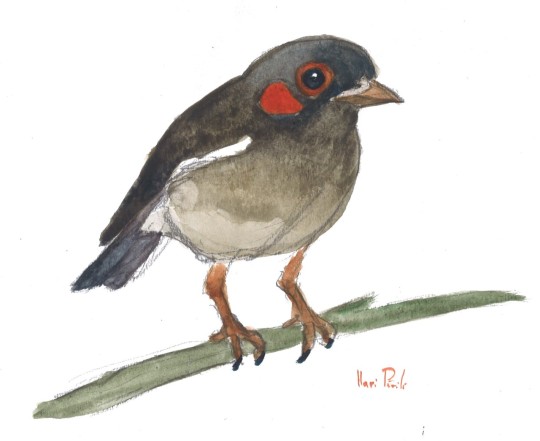
Eofringillirostrum by @otussketching
From these animals eventually came Passerines, though they were not especially common to begin with - many other birds lived in trees too, such as Mousebirds, and like all great dynasties, Passerines needed time to get started. That doesn't mean they weren't around - Eofringillirostrum, one of the smallest fossil dinosaurs we have, was already living kind of like a modern finch, without being closely related to them!
What's weird, however, is that most of our earliest known passerine and stem-passerine fossils are from North America and Europe. This is, however, a sampling bias - we just have spent more time looking for fossils in these locations. The "most basal" (ie, earliest-branching) passerines and parrots are both found in Aotearoa today - indicating that this clade probably diverged and first appeared somewhere in Oceania. Hopefully, fossils of these early Passerine-Parrots will be found in the region soon!
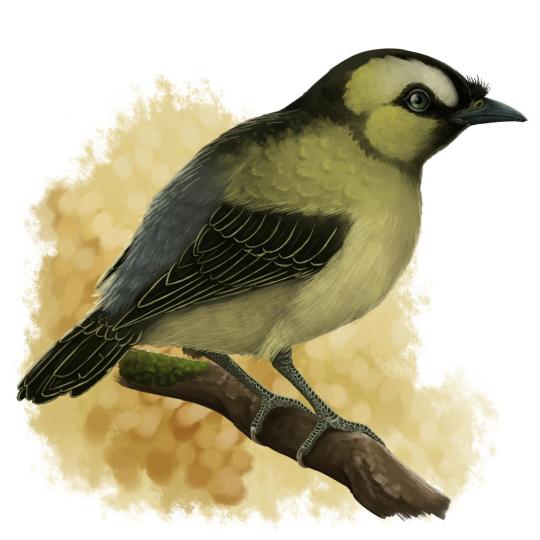
Wieslochia by @drawingwithdinosaurs
Alas, Passerine fossils of any kind do not become particularly common until the early Miocene, indicating that the climate change occurring globally at the time did allow Passerines to diversify more than they had previously. Perhaps Passerines were more adaptable to colder and drier climates than other tree birds had been, or their specialized perching feet allowed them to live easier in different types of forests. By the late Miocene, modern genera were even appearing. Though these delicately boned dinosaurs do not fossilize easily, more and more of the puzzle is showcasing how we got to the point where half of all living dinosaurs belong to this group.
In fact, thanks to genomics, we have something of an idea as to why Passerines speciate at the drop of a hat - and that reason is recombination! For some reason, Passeriformes are more prone to genomic restructuring and shuffling, with even short periods of separation between populations leading to rapid accumulation of these genomic architectural differences. Between that and the variety of ecologies such small arboreal animals can inhabit, it was just a perfect set of conditions for so many species to evolve - and honestly? I doubt Passeriformes are going anywhere any time soon.
Sources:
Conway, M., B. J. Olsen. 2019. Contrasting drivers of diversification rates on islands and continents across three passerine families. Proceedings of the Royal Society B 286(1915): 20191757.
Gibb, G. C., R. England, G. Hartig, P. A. McLenachan, B. L. Taylor Smith, B. J. McComish, A. Cooper, D. Penny. 2015. New Zealand Passerines Help Clarify the Diversification of Major Songbird Lineages during the Oligocene. Genome Biology and Evolution 7(11): 2983-2995.
Manthey, J. D., J. Klicka, G. M. Spellman. 2021. The Genomic Signature of Allopatric Speciation in a Songbird is Shaped by Genome Architecture (Aves: Certhia americana). Genome Biology and Evolution 13(8): evab120.
Mayr, G., A. C. Kitchener. 2022. Psittacopedids and zygodactylids: the diverse and species-rich Psittacopasserine birds from the early Eocen London Clay of Walton-on-the-Naze (Essex, UK). Historical Biology 35 (12): 2372-2395.
Mayr, 2022. Paleogene Fossil Birds, 2nd Edition. Springer Cham.
Mayr, 2017. Avian Evolution: The Fossil Record of Birds and its Paleobiological Significance (TOPA Topics in Paleobiology). Wiley Blackwell.
Mayr, G. and A. Manegold. 2006. New specimens of the earliest European passeriform bird. Acta Palaeontologica Polonica 51(2):315-323.
139 notes
·
View notes
Photo
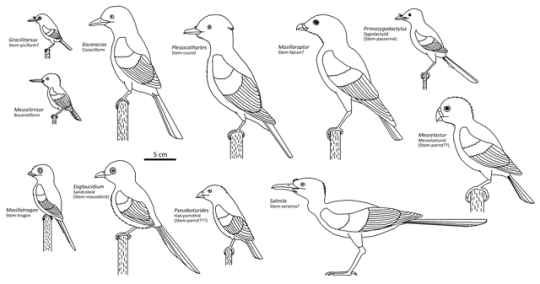
After forests recovered from their devastation by the Cretaceous mass extinction 66 million years ago, the few surviving dinosaurs quickly radiated into vacant arboreal niches. Among these new tree-dwelling birds, the most diverse were members of the clade Telluraves, a group that would give rise to hawks, owls, hornbills, kingfishers, woodpeckers, falcons, parrots, songbirds, and many more.
Here are a few 47-million-year-old telluravians whose fossils were found in the Messel Shale of Germany.
#Birds#Dinosaurs#Palaeoblr#Telluravians#Messelirissor#Gracilitarsus#Eocoracias#Masillatrogon#Eoglaucidium#Pseudasturides#Plesiocathartes#Masillaraptor#Salmila#Messelastur#Primozygodactylus
19 notes
·
View notes
Text
Primozygodactylus danielsi, P. ballmanni, P. major, P. eunjooae, P. quintus, P. longibrachium
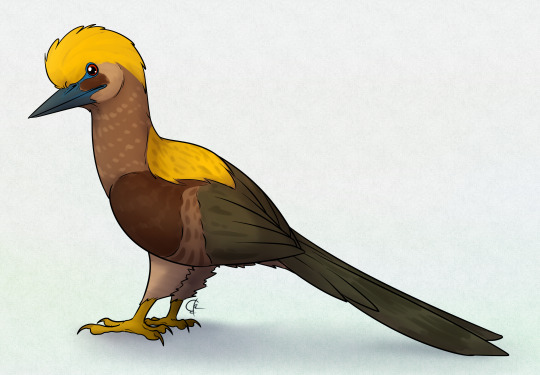
By José Carlos Cortés on @quetzalcuetzpalin-art
PLEASE SUPPORT US ON PATREON. EACH and EVERY DONATION helps to keep this blog running! Any amount, even ONE DOLLAR is APPRECIATED! IF YOU ENJOY THIS CONTENT, please CONSIDER DONATING!
Name: Primozygodactylus danielsi, P. ballmanni, P. major, P. eunjooae, P. quintus, P. longibrachium
Status: Extinct
First Described: 1998
Described By: Mayr
Classification: Dinosauria, Theropoda, Neotheropoda, Averostra, Tetanurae, Orionides, Avetheropoda, Coelurosauria, Tyrannoraptora, Maniraptoriformes, Maniraptora, Pennaraptora, Paraves, Eumaniraptora, Averaptora, Avialae, Euavialae, Avebrevicauda, Pygostylia, Ornithothoraces, Euornithes, Ornithuromorpha, Ornithurae, Neornithes, Neognathae, Neoaves, Australaves, Psittacopasserae, Passeriformes, Zygodactylidae
Primozygodactylus is a well known Zygodactylid, so well known that it actually has six species ascribed to it, all of them coming from the Messel Pit of Germany, thus living about 48 million years ago, in the Ypresian age of the Eocene of the Paleogene. The five species of Primozygodactylus are primarily distinguished from one another due to differences in body proportion. P. major is the smallest of all of them; P. ballmanni has a short beak and shorter wings, P. danielsi has long toes, P. eunjooae has a large size and long wings, and P. quintus had a long beak with long nostrils, and an average size, and P. longibrachium had very long wings and short legs. Feathers have been preserved in the species, showing barbules and long tail feathers. Its long and slender beak across the genus means that it was probably mainly an insect eater, gathering arthropods from trees in its forested environment, using the unique Zygodactylid parrot foot - passerine leg combo to perch well in the branches. It also supplemented its diet with berries. They also probably did foraging in the undergrowth and scrub of the forest, using their long legs to aid in moving quickly across the ground. Interestingly enough, it seems that Zygodactylus, which primarily came later (and earlier referred species probably aren’t a part of the genus) might actually have descended from the species complex of Primozygodactylus - meaning the genus for Primozygodactylus is paraphyletic with respect to Zygodactylus, though since genera quite often aren’t monophyletic, that probably won’t lead to any changes in naming.
Source:
Mayr, G. 2009. Paleogene Fossil Birds. Springer-Verlag Berlin Heidelberg.
Mayr, G. 2016. New species of Primozygodactylus from Messel and the ecomorphology and evolutionary significance of early Eocene zygodactylid birds (Aves, Zygodactylidae). Historical Biology.
#primozygodactylus#bird#dinosaur#birblr#palaeoblr#primozygodactylus danielsi#primozygodactylus ballmani#primozygodactylus major#primozygodactylus eunjooae#primozygodactylus quintus#primozygodactylus longibrachium#paleontology#prehistory#prehistoric life#dinosaurs#biology#a dinosaur a day#a-dinosaur-a-day#dinosaur of the day#dinosaur-of-the-day#science#nature#factfile#Dìneasar#דינוזאור#डायनासोर#ديناصور#ডাইনোসর#risaeðla#ڈایناسور
34 notes
·
View notes
Text
Eocoracias brachyptera
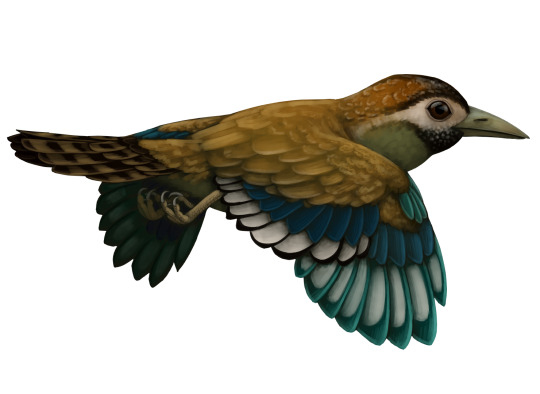
By Scott Reid
Etymology: Dawn Near Crow
First Described By: Mayr & Mourer-Chauvire, 2000
Classification: Dinosauromorpha, Dinosauriformes, Dracohors, Dinosauria, Saurischia, Eusaurischia, Theropoda, Neotheropoda, Averostra, Tetanurae, Orionides, Avetheropoda, Coelurosauria, Tyrannoraptora, Maniraptoromorpha, Maniraptoriformes, Maniraptora, Pennaraptora, Paraves, Eumaniraptora, Averaptora, Avialae, Euavialae, Avebrevicauda, Pygostaylia, Ornithothoraces, Euornithes, Ornithuromorpha, Ornithurae, Neornithes, Neognathae, Neoaves, Inopinaves, Telluraves, Afroaves, Coraciimorphae, Cavitaves, Eucavitaves, Picocoraciae, Picodynastornithes, Coraciiformes, Eocoraciidae
Status: Extinct
Time and Place: 48 million years ago, in the Ypresian age of the Eocene of the Paleogene

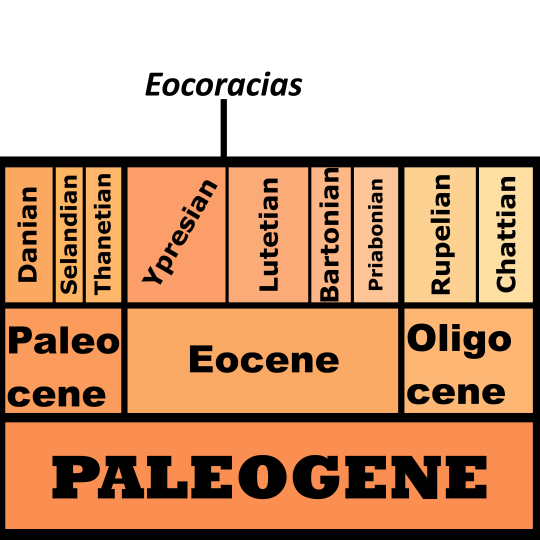
Eocoracias was found in the Messel Pit formation of Darmstadt-Dieburg, Germany

Physical Description: Eocoracias was an early, transitional relative of modern rollers - a group of predatory, tree-dwelling birds that often feature bright, distinctive colors and patterns in their feathers. Eocoracias itself resembled rollers and their closest relatives alike, showcasing how this group of birds evolved (rollers being closely related to animals such as kingfishers). Overall, it looked a lot like modern rollers - it had a large head compared to the rest of its body, a relatively rectangular front of the head, though its eyes were not developed quite the same as modern roller eyes. In addition, its skull wasn’t quite as long and thin as modern rollers, though it did have as robust a beak as its living relatives. It had smaller toe bones than other rollers, though it is unlikely that this would have translated to it being less arboreal than its modern relatives. This is corroborated by the fact that its legs were somewhat short, though still similar to living rollers. It also had shorter wings than living members of the group, as well as long tail feathers, similar to modern Ground Rollers. In overall size, it was about the same size as a modern jay - around 35 centimeters in length, so a little bigger than most modern rollers.
Diet: Unlike its modern relatives, Eocoracias was not exclusively a meat-eater; instead, seeds have been found in its stomach in addition to animal material, indicating that Eocoracias was more of a generalized feeder. As an omnivore, it would have fed upon seeds, insects, fruit, and maybe even small vertebrates.
Behavior: Though Eocoracias was probably more closely related to modern Rollers, its overall body shape actually resembled Ground Rollers more closely. As such, it might have had a more similar lifestyle to Ground Rollers than to Rollers. Its short, triangular wings would have been useful in more short bursts of flight and agile maneuvering; its sturdier legs meant that, though it was still arboreal, it probably spent more time on the ground than modern rollers. In addition, it may have even nested in holes on the ground, rather than holes in trees like modern Rollers.
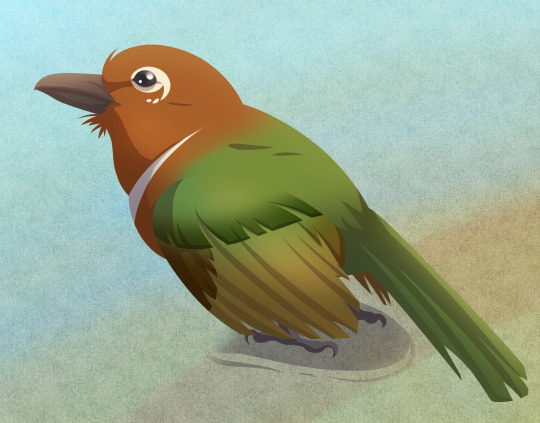
By José Carlos Cortés
Ecosystem: The Messel Pit was an extremely diverse and important ecosystem from the middle of the Eocene, showcasing how life began to transition into modern forms. Precursors of modern mammals and birds are common in the fossils from the Messel Pit, as well as other groups of animals such as insects, fish, and reptiles; in addition, plants showcase the unique climate and environment of the planet at this time. This environment was during the Global Rainforest period of the first half of the Eocene, in which the world was warm and wet, and covered with rainforest environments. The Messel Pit environment was no different; the area that the fossils represent was a large lake, surrounded by an extensive forest ecosystem. Volcanic gases were also common within the lake, which would have overwhelmed the animals living around it and caused mass deaths, allowing their bodies to fall into the lake and leading to their exceptional preservation.
Though it’s impossible to list all the animals that lived alongside Eocoracias, some notable dinosaurs that also lived in the Messel Pit along with Eocoracias include other Coraciiformes like Messelirrisor and Primobucco. The early relative of songbirds, Primozygodactylus, was a common feature in the area. The parrot of prey Messelastur was also present, as was the early seriema-like Strigogyps and the tiny owl Palaeoglaux. Early primates, rodents, bats, horses, and Leptictidium also lived in the area. Though it wasn’t found with it, Gastornis also probably would have frequented the environment of Eocoracias, though since Gastornis fed upon fruit, it wouldn’t have eaten Eocoracias. Instead, Messelastur and Strigogyps might have been main the predators of Eocoracias.
Interestingly enough, though this was an intensely forested environment, none of the tree-dwelling birds got as large as modern crows; this was probably due to the density of the vegetation.
Other: Eocoracias is known from multiple individuals, indicating it was fairly common within the Messel ecosystem.
~ By Meig Dickson
Sources under the cut
Mayr, G., C. Mourer-Chauviré. 2000. Rollers (Aves: Coraciiformes s.s.) from the Middle Eocene of Messel (germany) and Upper Eocene of the Quercy (France). Journal of Vertebrate Paleontology 20 (3): 533 - 546.
Mayr, G. 2009. Paleogene Fossil Birds. Springer-Verlag Berlin Heidelberg.
Mayr, G. 2016. The early Eocene birds of the Messel fossil site: a 48 million-year-old bird community adds a temporal perspective to the evolution of tropical avifaunas. Biological Reviews 92 (2): 1174 - 1188.
Mezger, J. E., M. Felder, F.-J. Harms. 2013. Crystalline rocks in the maar deposits of Messel: key to understanding the geometries of the Messel Fault Zone and didatreme and the post-eruptional development of the basin fill. Journal of the German Geosciences Society 164 (4): 639 - 662.
#eocoracias#dinosaur#bird#roller#omnivore#paleogene#eurasia#palaeoblr#birblr#factfile#afroavian#coraciiform#eocoracias brachyptera#birds#dinosaurs#paleontology#prehistory#prehistoric life#biology#a dinosaur a day#a-dinosaur-a-day#dinosaur of the day#dinosaur-of-the-day#science#nature
206 notes
·
View notes